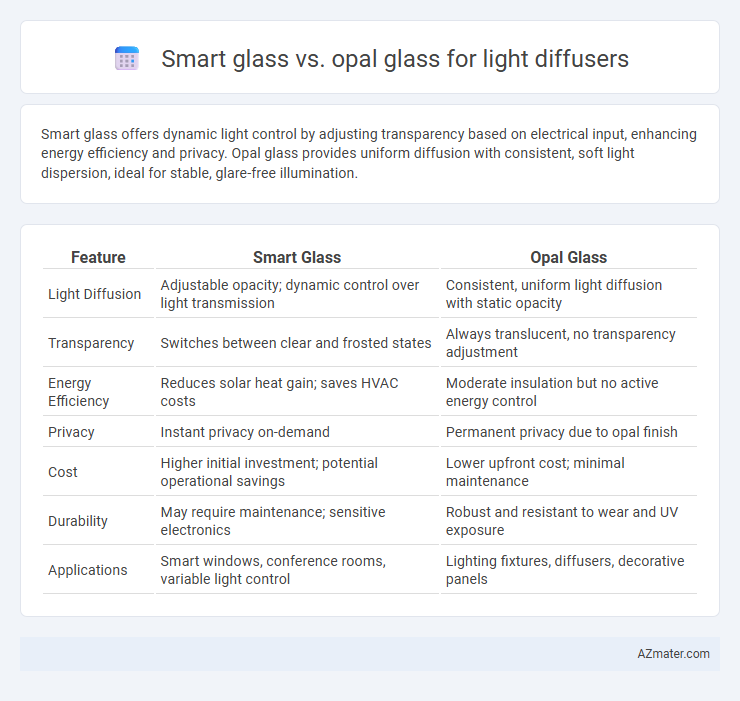Smart glass offers dynamic light control by adjusting transparency based on electrical input, enhancing energy efficiency and privacy. Opal glass provides uniform diffusion with consistent, soft light dispersion, ideal for stable, glare-free illumination.
Table of Comparison
| Feature | Smart Glass | Opal Glass |
|---|---|---|
| Light Diffusion | Adjustable opacity; dynamic control over light transmission | Consistent, uniform light diffusion with static opacity |
| Transparency | Switches between clear and frosted states | Always translucent, no transparency adjustment |
| Energy Efficiency | Reduces solar heat gain; saves HVAC costs | Moderate insulation but no active energy control |
| Privacy | Instant privacy on-demand | Permanent privacy due to opal finish |
| Cost | Higher initial investment; potential operational savings | Lower upfront cost; minimal maintenance |
| Durability | May require maintenance; sensitive electronics | Robust and resistant to wear and UV exposure |
| Applications | Smart windows, conference rooms, variable light control | Lighting fixtures, diffusers, decorative panels |
Introduction to Light Diffusers: Smart Glass vs Opal Glass
Smart glass and opal glass serve as effective light diffusers by controlling light transmission and enhancing privacy while maintaining aesthetic appeal. Smart glass uses electrochromic technology to adjust opacity dynamically, offering customizable light diffusion and energy efficiency, whereas opal glass provides consistent, milky translucency that evenly disperses light without electronic control. Both materials optimize natural and artificial lighting but differ significantly in functionality, cost, and integration in architectural and interior design applications.
Understanding Smart Glass: Features and Technology
Smart glass employs advanced electrochromic or polymer-dispersed liquid crystal (PDLC) technology to dynamically control light transmission, providing instant switchability between transparent and opaque states. This adaptability enhances privacy and energy efficiency in architectural and automotive applications by modulating glare and heat. Unlike opal glass, which relies on fixed diffusion through its milky, frosted appearance, smart glass offers customizable light diffusion, optimizing natural light while maintaining user control.
What is Opal Glass? Key Properties and Benefits
Opal glass is a type of frosted or milky white glass characterized by its translucent appearance that diffuses light evenly, minimizing glare and hotspots. Its key properties include high light diffusion, UV resistance, thermal stability, and durability, making it ideal for lighting applications requiring soft, uniform illumination. The benefits of opal glass include enhanced visual comfort, reduced eye strain, and aesthetic versatility in both residential and commercial light fixtures compared to smart glass, which offers adjustable transparency but less diffusion uniformity.
Light Transmission: Comparing Diffusion Performance
Smart glass typically offers adjustable light transmission, allowing users to control opacity and achieve variable diffusion levels, ideal for creating privacy while maintaining natural light. Opal glass provides consistent, uniform diffusion with high light transmission rates, producing soft, glare-free illumination suited for architectural lighting and display applications. In terms of diffusion performance, Opal glass ensures steady light scattering, whereas smart glass emphasizes customizable transparency with slightly reduced light diffusion when in opaque mode.
Energy Efficiency: Which Glass Performs Better?
Smart glass offers superior energy efficiency compared to opal glass by actively controlling light transmission and heat flow, reducing the need for artificial lighting and air conditioning. Its electrochromic technology allows dynamic adjustment to daylight levels and solar heat gain, contributing to significant energy savings in buildings. Opal glass diffuses light uniformly but lacks the adaptive thermal control features, making it less effective in optimizing energy consumption.
Aesthetics and Design Flexibility
Smart glass offers dynamic translucency control, allowing real-time adjustment of light diffusion and privacy, enhancing aesthetic appeal in modern architectural designs. Opal glass provides a consistent, soft, and uniform light diffusion with a classic matte finish, ideal for creating a timeless and elegant ambiance. Design flexibility with smart glass includes the integration of technology for customizable opacity settings, while opal glass excels in applications requiring reliable, maintenance-free diffusion with a wide variety of shapes and sizes.
Installation and Maintenance Requirements
Smart glass installation requires electrical wiring integration and professional expertise, while opal glass can be installed using conventional mounting methods without specialized skills. Maintenance for smart glass involves occasional electronic component checks and potential software updates, contrasting with opal glass's low-maintenance cleaning needs and longer-term durability without electronic parts. Both materials offer effective light diffusion, but smart glass demands higher installation complexity and ongoing electronic care compared to the straightforward upkeep of opal glass.
Cost Comparison: Initial Investment and Long-Term Value
Smart glass typically demands a higher initial investment due to advanced technology and installation costs, whereas Opal glass offers a more affordable upfront price with simpler manufacturing. Long-term value of smart glass includes energy savings and adjustable light diffusion, potentially offsetting its cost over time, while Opal glass provides consistent diffusion with minimal maintenance but lacks dynamic control. Evaluating project scale and energy efficiency requirements is crucial to determine which option delivers better cost-effectiveness over the lifespan.
Applications: Where Each Type Excels
Smart glass excels in applications requiring dynamic light control and privacy, such as office partitions, conference rooms, and automotive windows where adjustable opacity is key. Opal glass is ideal for consistent, soft light diffusion in lighting fixtures, skylights, and decorative lamps, offering uniform illumination without glare. Both materials enhance energy efficiency and aesthetic appeal but serve distinct functional needs based on whether variable transparency or steady diffusion is required.
Choosing the Right Light Diffuser: Smart Glass or Opal Glass?
Smart glass offers dynamic light control by electronically adjusting transparency to optimize natural light and reduce glare, making it ideal for flexible environments requiring privacy and energy efficiency. Opal glass provides consistent, even light diffusion with a matte finish that softens illumination and minimizes harsh shadows, perfect for applications prioritizing uniform brightness and aesthetic appeal. Choosing the right light diffuser depends on balancing the need for adaptability and functionality with the desired visual effect and energy-saving goals.

Infographic: Smart glass vs Opal glass for Light diffuser
 azmater.com
azmater.com